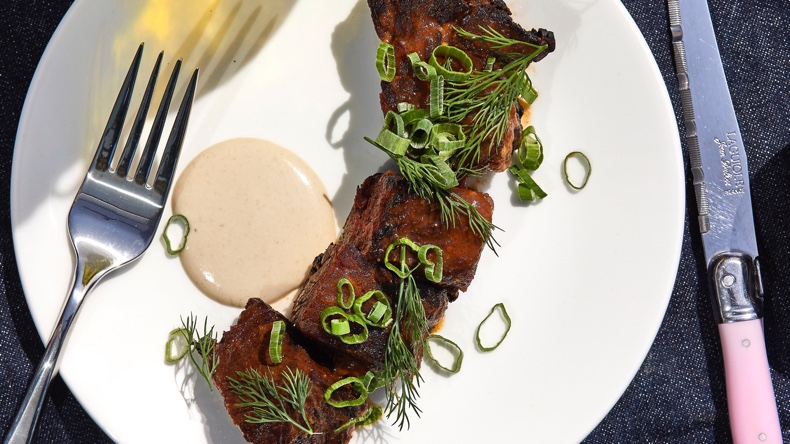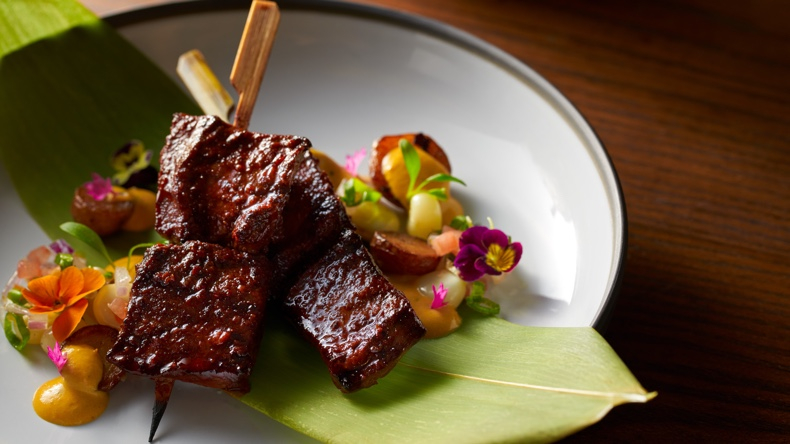Food
We're Fired Up About These Five Global Street Food-Inspired Skewers
Street food has long captivated chefs, and skewers—a near universal expression of street cooking—have found a permanent home in American restaurants of all types and with all manner of kitchen setups. From a highvolume satay food truck to an Israeli grilling concept and a fine-dining Peruvian restaurant, we found five chefs who are innovating, adapting, and firing up the almighty skewer.
Dibi in a Western Setup
When Chef Cleophus Hethington took over Benne on Eagle in Asheville, N.C., he inherited a kitchen known for layering Black and Appalachian foodways. “I’m not Southern. I don’t know Southern cuisine,” says Hethington, who grew up in Miami. “I consider myself a citizen of the world.” Benne on Eagle’s menu now reflects Hethington’s travels to and study of cuisines in Africa, El Salvador, Brazil, and the Caribbean. In an ideal world, he’d have his “whole damn line be a wood-fired grill” to tie his food and flavors to their origins, but for dishes like Senegalese dibi, he makes do with a standard gas grill. A traditional street food, dibi is normally made of marinated and grilled lamb that’s dusted with peanut-based tankora powder (a West African dry rub) and accompanied by a tangy mustard sauce. Hethington breaks down whole lamb legs for his version and swaps pistachios in for peanuts in the tankora. He serves the skewer with fonio and cipollinis braised in mustard beurre blanc (a nod to French influence in Senegal).
Skewer: Lamb dibi
Cut: Lamb leg, deboned, and cut into 1/2-ounce pieces
Marinade: Tomato paste, ancho chile, garlic, ginger, shallots, green cardamom, and mustard powder for a few hours
Portion: Thread 4 to 5 pieces of lamb on each skewer
Pick-up: Cook 3 to 4 minutes on a gas grill and finish in 500°F oven, until medium doneness
Extras: Dust with tankora and plate 2 skewers with fonio and Dijon cipollinis

Short Rib, Braised and Skewered
In anticipation of opening Laser Wolf, Chef Andrew Henshaw made a long-awaited culinary pilgrimage to Israel, where he witnessed street vendors on nearly every block, cranking out a parade of skewers and pita from 2-foot-by-1-foot grills. “The volume they could serve from a tiny space was ridiculous,” he says. At Laser Wolf, now with locations in Philadelphia and Brooklyn, guests order from a menu of grilled shishlik, kebabs, and large-format mains, and their tables are loaded with 10- plus seasonal salatim (dips, spreads, and salads) from the kitchen. To streamline firing times, the team portions all proteins and vegetables so they have the same cooking time. High-fat kebabs are shaped long and thin; chicken is cut into 1 1/2-ounce pieces, and steak into 3/4- to 1-ounce bites. While Henshaw admires the simplicity of Israeli grilled meats, he’s also taking liberties with dishes like braised short rib shishlik. He once sold short rib for two to 10 tables a night, but in skewer form, his team can send out 50 to 60 orders—a move that’s good for guests and food costs.
Skewer: Barbecue short rib shishlik
Prep: Cure short ribs overnight in salt and barbecue spices (sweet and hot paprika, cumin, pepper, and onion and garlic powders); braise 4 hours in ketchup, brown sugar, amba, beef stock, and passion fruit purée. Cool meat. Reduce braising liquid for basting.
Cut: Cut short rib into 1-ounce pieces
Portion: 5 ounces per skewer
Pick-up: Over marabu charcoal (made from a tree invasive to Cuba), cook 6 to 8 minutes, flipping every 1 1/2 to 2 minutes, glazing each side a few times
Extras: Remove from skewers and plate with tahina

Beefy Tuna Bloodlines
Chef Shaun Brian Sells wants CudaCo., a retail and wholesale seafood market on James Island, S.C., to build a culture around sustainable sourcing and whole-fish utilization. That means turning his customers away from a diet of fillets and onto house bottarga, trash fish, and trim. To help the cause, Sells stocks his case with a variety of marinated fish skewers (most of which are composed of trim weight), which he sells for $18 per pound togo or seared in-house. One standout is his yellowfin bloodline skewer, which he cooked for customers for free until demand for the unexpectedly beefy dish caught on. “Throughout my entire professional career everyone has thrown away the bloodline, except one time 10 or 15 years ago, I saw Japanese chefs doing bloodline yakitori,” says Sells. “I treat it like I’m cooking Wagyu or another high-quality cut of beef.”
Skewer: Yellowfin tuna bloodline
Cut: Slice on a hard bias into pieces 4 inches wide and less than a 1/4 inch thick
Marinade: 24 hours in oyster sauce and garlic-chile sambal
Portion: 3 ounces; 4 bloodline slices skewered ribbon-style
Pick-up: 20 to 30 seconds per side in a dry, ripping-hot steel pan
Extras: Finish with olive oil and smoked sea salt

Scaling Up Satay
Running Satay by the Bay is a calling for Elly Suraya Greenfield, an insurance agent turned chef who grew up working in her mother’s catering business in Singapore. “In Singapore, the number-one sport is eating,” she says. After a slow 2020 launch, the Bay Area food truck is now selling 1,600 to 1,800 halal chicken skewers a week, and Suraya Greenfield recently bought cutting and skewering machines to keep up with demand—a rarity outside of Southeast Asia, she says. Suraya Greenfield’s recipe is traditional Singaporean. “What makes it magical is my grandmother’s peanut sauce. The difference is my grandmother was Javanese, and Javanese must have chile spice, sweetness, and sourness from tamarind,” she says. “A Malaysian customer pointed out he never had peanut sauce with tamarind. That hint of acid makes it distinct.”
Skewer: Chicken satay
Cut: Thin strips, sliced with an American Eagle meat cutter
Marinade: Onion, garlic, ginger powder, sugar, molasses, coriander, cumin, and fennel powder for 24 hours
Portion: 1.8 ounces; Suraya Greenfield places chicken chunks into narrow plastic molds and skewers the meat with a specialty satay-skewering machine
Pick-up: 4 minutes per side on a 4-foot gas grill; for large events, cook skewers a half hour in advance, keep warm in a steamer, and flash sear to order
Extras: Serve with peanut sauce, rice, cucumber, and onions

Grilled from the Heart
Anticucho is Peru’s most important street food, and the king of anticucho is beef heart, according to Chef Diego Oka of Miami’s La Mar. “It reflects the African influence on Peruvian cooking. Spanish bosses would give enslaved workers offal. They started cooking with it and perfected the technique,” he says. For years, Oka has served veal heart anticucho at La Mar, and though diners were skeptical at first, it’s become a menu anchor. “Veal heart is super tender and has great flavor and really good food cost,” says Oka of the Argentine meat he sources and sells for $15 a skewer. At pick-up, Oka’s team uses a combination of charcoal grilling and searing to mimic the smoke and caramelization achieved by Lima’s specialized anticucho grills. “The street grills are almost like a flat-top, but cut with thin lines,” says Oka, who’s currently working with a designer on a new grill for La Mar’s anticucho bar.
Skewer: Veal heart anticucho
Cut: Butterfly heart, removing membranes, veins, and valves; cut into 1 1/2-ounce pieces
Marinade: Ají panca paste, cumin, oregano, black pepper, red wine vinegar, salt, garlic, and neutral oil for a few hours; Oka cautions against marinating too long less the bloody heart tissue get “stinky”
Portion: 3 ounces; 2 pieces of meat per skewer
Pick-up: Cook 3 minutes on a flat-top and finish on the grill, cooking 2 minutes more to medium doneness
Extras: Plate with confit potatoes, crispy choclo (Peruvian corn), and rocoto-spiced huancaina sauce
Caroline Hatchett is senior editor for Plate.
